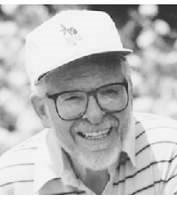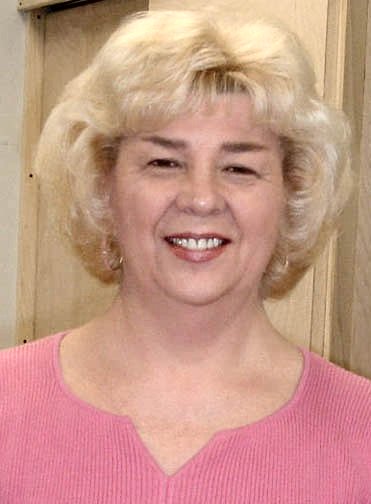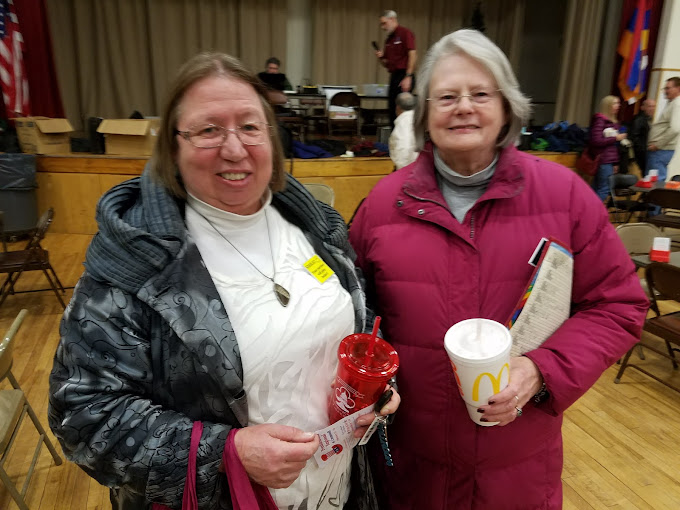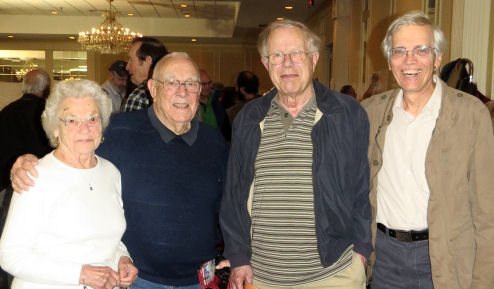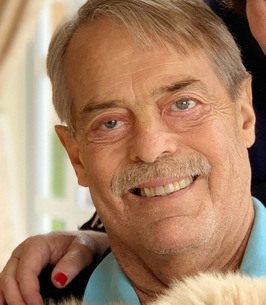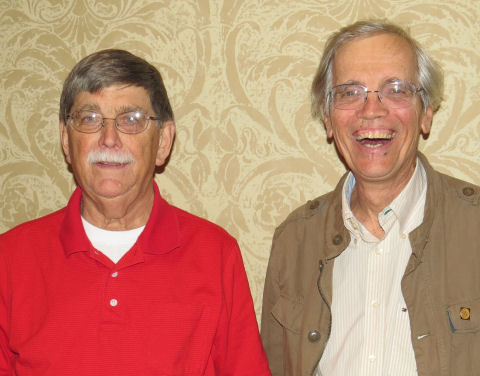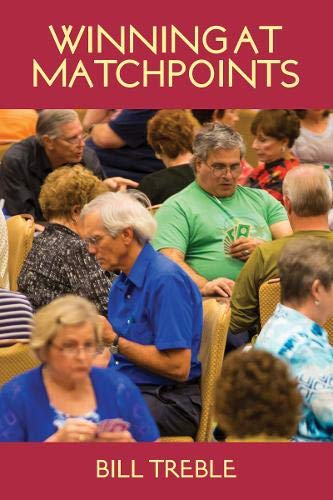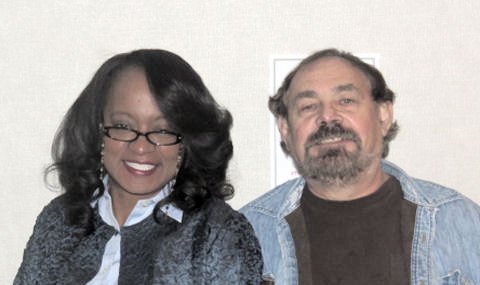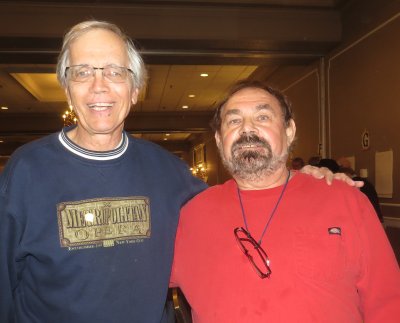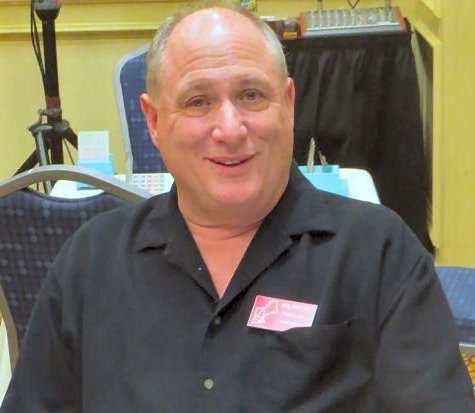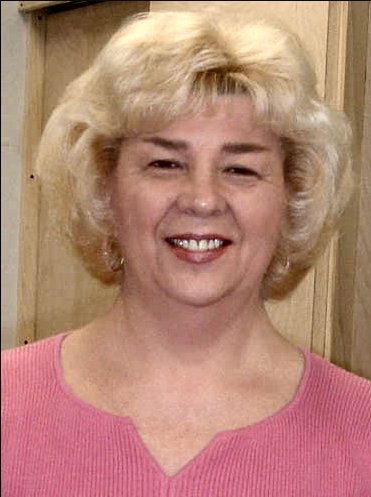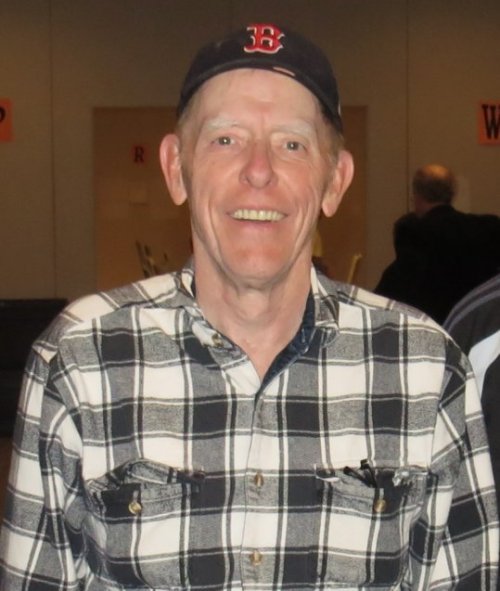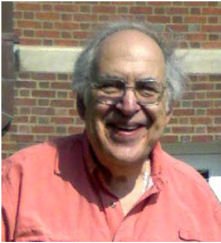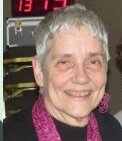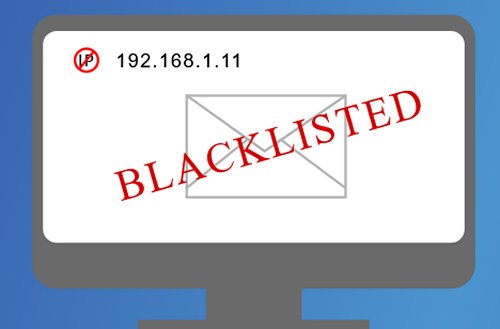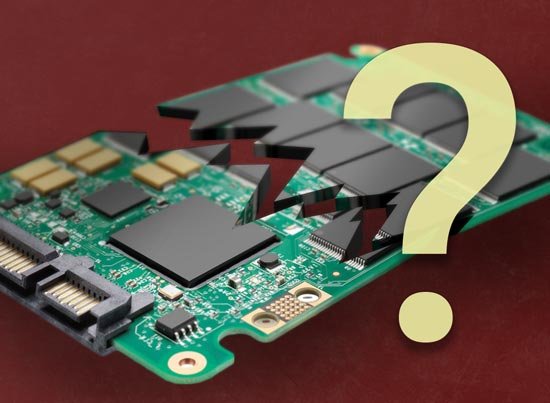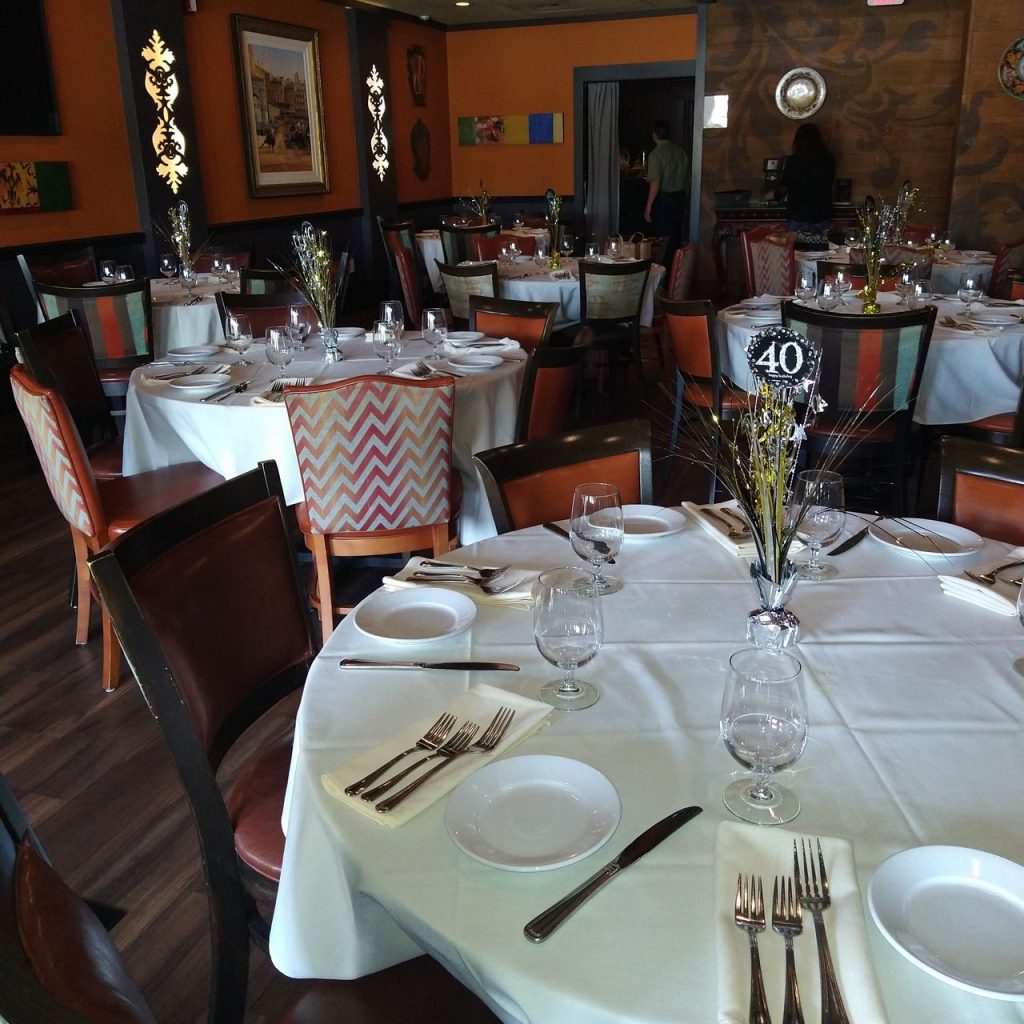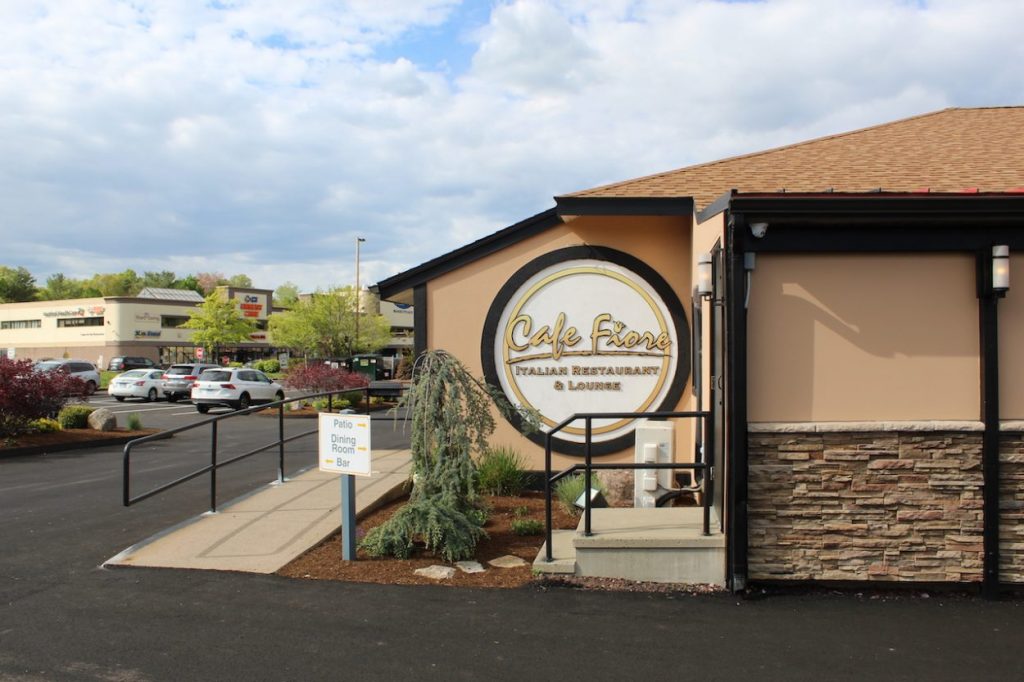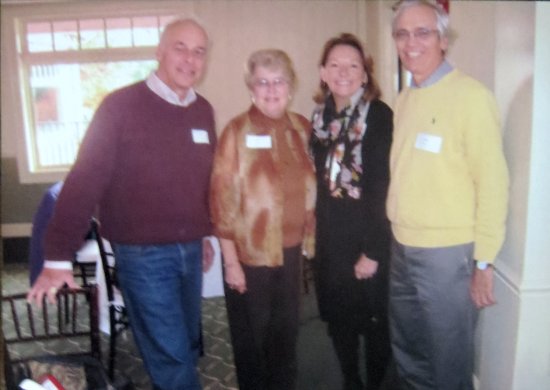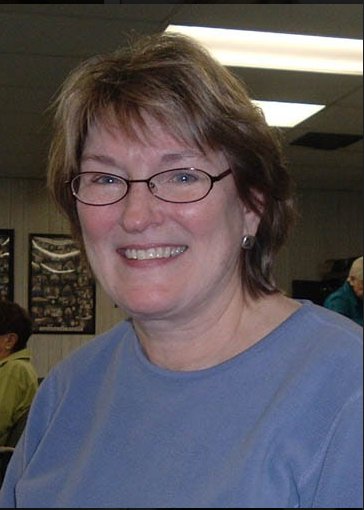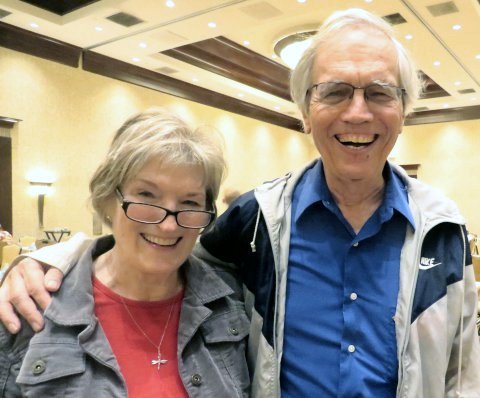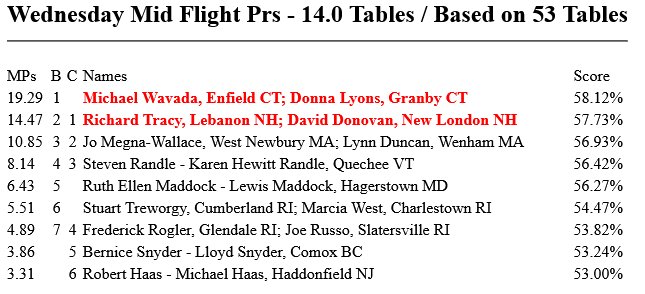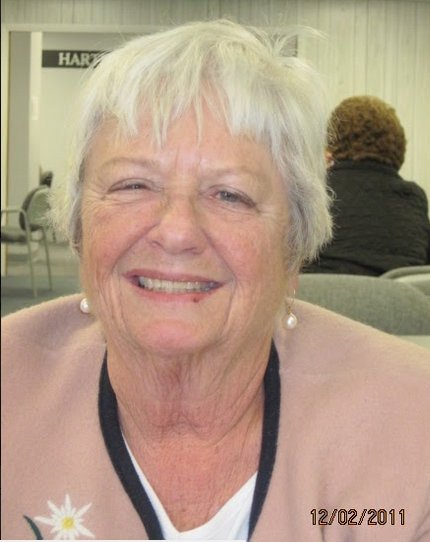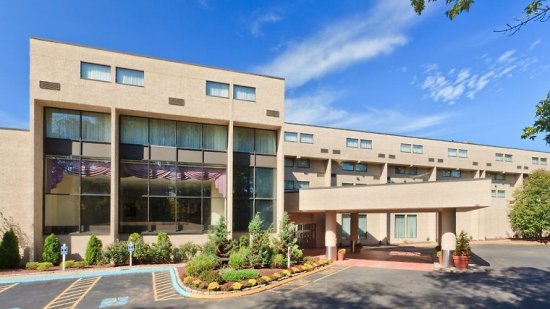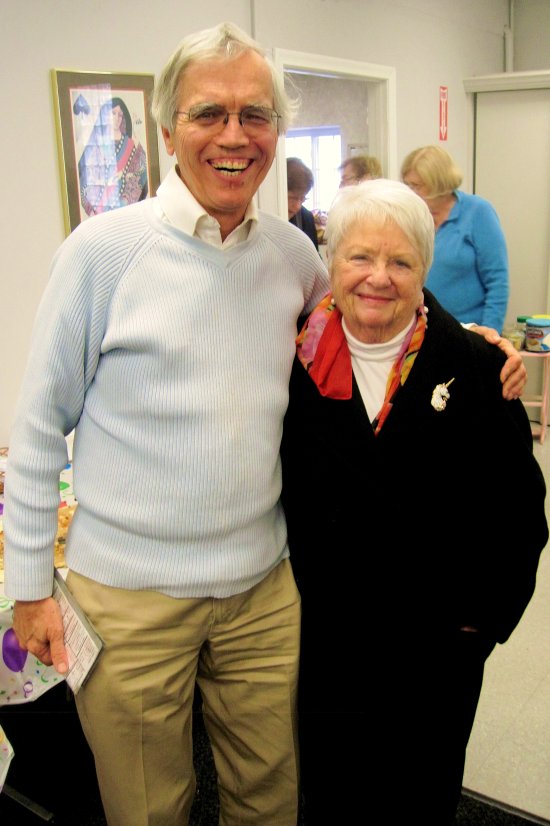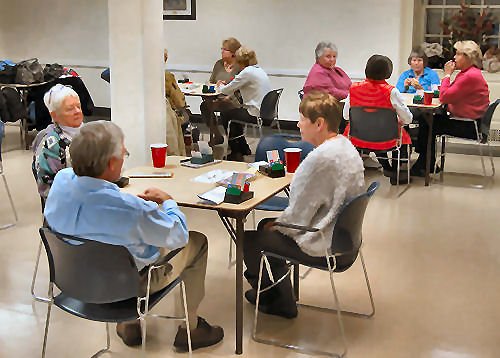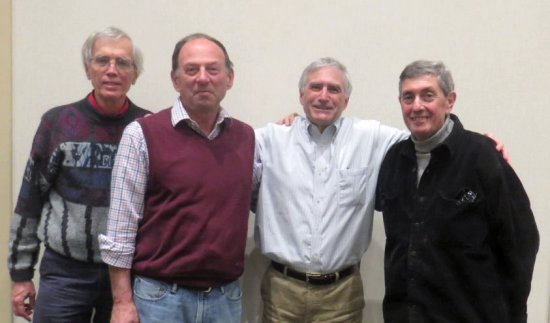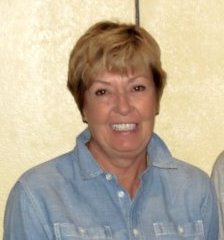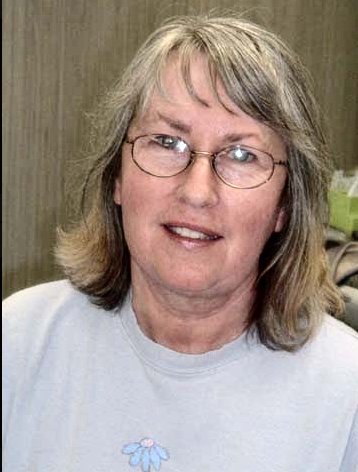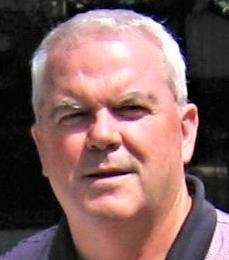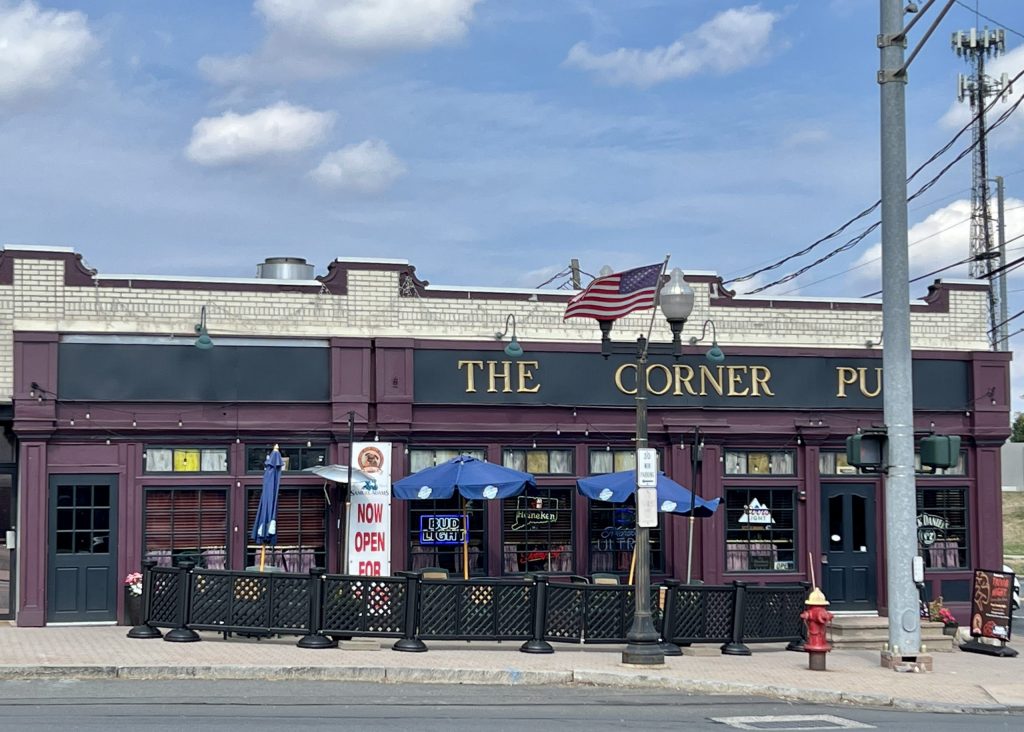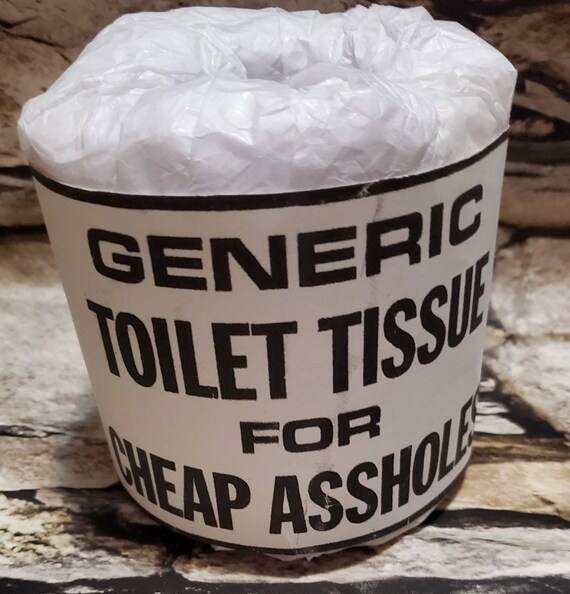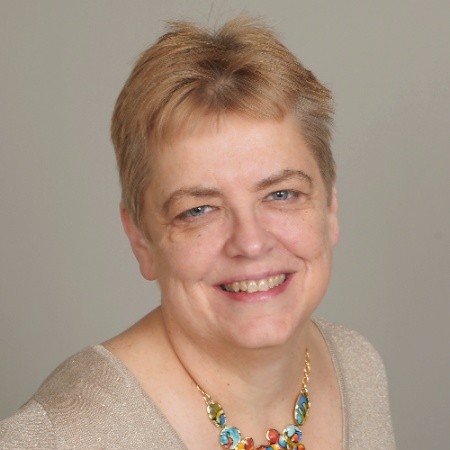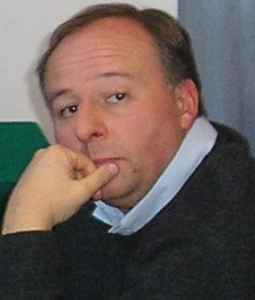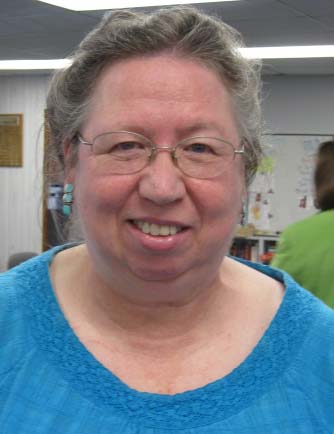Occasional partners at tournaments. Continue reading
One of the very first tournaments that I ever attended was in the Fiesta Regional in Waterbury, CT, in the summer of 2007. I was planning to play with Dick Benedict (introduced here) in the Bracketed Swiss on Labor Day. On one of the weekend days I drove to the Holiday Inn that hosted the tournament by myself in hope of picking up a partner for both sessions of pairs. The person at the Partnership Desk was Carol Schaper (introduced here), whom I knew from the Simsbury Bridge Club (SBC).
Carol matched me up with John Morrin to play in the 299er game in the morning. Dick dropped by the 299er room and said that he was glad that John and I had met. We played pretty well, but we failed to win any points because of a defensive lapse. One of us held the ace in a side suit and the other held the king. We both avoided the suit, and the opponents made a contract that they should not have.
I have played against John many times at the Hartford Bridge Club (HBC), at which he still was playing regularly in 2023, but that long-ago game in Waterbury was the only time that we have played as partners.
In the afternoon session in Waterbury I played with Mort Friedman in an event that I had no business playing, the Open Pairs. He was 26 years older than I was and as gregarious as I was introverted. He had come to the tournament from the Albany area. He knew all of our opponents, and he introduced me to them as a “new player”.
Mort thought at the end of the round that we might have placed, but he was overly optimistic. I probably made some simple errors that he did not pick up on.
At the time Mort published a bridge column called “Bridging the Gap”. He emailed it to me for several years, and I occasionally asked him questions about it. He always responded.
Mort died in 2011. His obituary can be found here.
I evidently received my first (fractional) gold points at the Waterbury tournament. Dick, Virginia Labbadia, Donald Fosberg (of whom I have no memory whatever) and I finished third in the bottom bracket of the Round Robin on Labor Day.
I was scheduled to play with Dick Benedict at an afternoon session of the sectional tournament at the Ukrainian National Home on Wethersfield Ave. in Hartford. Our signals got crossed, and, with just a few minutes before game time I discovered that he was not going to come. Lou Brown, who was president of the HBC at the time, also needed a partner. So, although he had much more experience than I did, we formed a one-time partnership.
I remember two things about the session. At one point we played against Mary Witt and Linda Starr. At the time they were both redheads. I question whether that was allowed by the ACBL. A few hands later Lou, as declarer, failed to follow suit even though I had warned him with the question “No hearts?.” He was very embarrassed by his mistake, which prevented us from placing in the event.
I have two other vivid memories of Dr. Brown. He occasionally played at the SBC with his wife Trudi. Quite often he was verbally abusive to her. I took Trudi aside and offered to talk to him about his behavior, which was clearly against the ACBL’s Zero Tolerance policy. She told me not to because, “For me it is like water off of a duck.”
I was present when Trudi got the gold points that she needed to become a Life Master. Lou and Trudi were paired with Merrill Stein and Gary Cohen. I don’t remember who our teammates were, but my partner was Michael Dworetsky. Merrill had bid 7NT on a hand. Michael was on lead on the first trick. For some reason he chose to lead “fourth best” from a spade suit headed by the king. It was a terrible choice that allowed Gary to take all thirteen tricks and win the match. If he had selected any other suit, he would have eventually won that king, and we would have won the event.
Lou and Trudi moved to Delray Beach, FL. They are both still active in the ACBL.
I am pretty sure that in the first event that I ever won I was playing with Dan Finn. Dan was an actuary who lived in the Baltimore area but spent a lot of time working in Connecticut. He played with Tom Gerchman at the HBC on Thursday evenings. He also played with John Morrin at the limited game (that I called 0-Finn) at the HBC on Wednesday evenings.
Dan and I played as partners with Tom Gerchman and his (only?) friend, Terry Fair, an actuary from the Philadelphia area, as teammates. The tournament was a sectional in District 3, probably in northern New Jersey.
We were playing in a B-C Swiss. Everything seemed to go our way. In the final round we played the only other team that was in contention. Our opponents made enough mistakes that I was certain that we had won. When Tom asked us whether we thought that we had done well enough, I asked him, “How many times did you revoke?”
He acted as if he did not understand the question. Dan intervened: “He wants to know how many times you revoked.” Gerchman muttered, “Uh, none.”
I said, “Then I think that we are OK.” I was right. We won the event.
On the way home I wanted to stop and get some real food. We were a long way from Enfield, and it was late. Gerch insisted on stopping at Dunkin Donuts.
Occasionally filling out a card at the Partnership Desk at a tournament brought a very pleasant surprise. Such was the case at the Masters Regional in Mansfield, MA, in 2013 when Ausra Geaski showed up without a partner. I was acquainted with her in three ways: 1) she was president of the district; 2) she arranged for me to become the district’s webmaster; 3) she was Bunny Kliman’s partner at the HBC and regionals and had a lot more points than I did. I don’t think that she was thrilled with the prospect, but she agreed to play with me in the open pairs.
I remember one hand from the round. We missed a slam in a notrump contract because one of us had a six-card diamond suit. It occurred to me that we should have used 2NT as a transfer to diamonds rather than signing off in 3NT. When partner accepted the diamond suit we could have found the slam.
The other thing that I remember was that Carole Weinstein was one of our opponents. She talked with Ausra about helping with the hospitality at the 2014 Fall NABC that was going to be held in Providence.
Ausra still played regularly at the HBC in 2023. She also played at a few sectionals, but she was hobbled by bad knees that she got replaced in October.
I came to know Marcia West, who lived in Charlestown, RI, from her association with Paul Pearson. She had taken a bridge class that Paul taught somewhere in Rhode Island. I don’t remember when I played with Marcia, but it must have been at a sectional in Johnston, RI. She did not often venture far from home for tournaments.
I don’t think that we did very well on that occasion, but Steve Smith and I teamed up with Marcia and Paula Najarian in an epic Round Robin at the first regional tournament ever held at the Crowne Plaza in Warwick, RI. I have recounted my heroic dummy play here.
I have been friends with Marcia and Paula for many years. Marcia was a nurse in real life; Paula taught math in high school. They both are still playing pretty regularly in 2023. Marcia played with my wife Sue at a sectional in Johnston, RI.
I am sure that I played with Vince D’Souza at a Unit 126 (Connecticut) sectional, but I cannot remember when or where. We were undoubtedly matched up by whoever was manning the partnership desk. I am even more certain that we did not do very well, but don’t ask me why.
Perhaps Vince remembers. In 2023 he contacted me about the lessons for beginners being offered by the HBC to beginning players. He wanted to purchase them for one of his sons or grandsons. He seemed to remember me better than I remembered him.
The LinkedIn page that is posted here is probably Vince’s. I was somewhat surprised to see that Vince was still a member of the ACBL in 2023. He played in the fall sectional in Orange, CT, but he did not earn any masterpoints.
I was assigned to play with Joe DaCosta at a regional tournament. I am not sure which one or when it occurred. I remember that he was expecting his partner to show up, but for some reason he suspected that he/she might not show up, and so he lined me up as a substitute. I had no choice; no one else was available..
We agreed to play his convention card, which included the Flannery convention, in which the 2♦ bid is used for hands with 11-15 high-card points, four spades and five or more hearts. Such hands are difficult to describe in most systems.
I played this convention every week with Peter Katz, and I had played it a few times with others. Joe asked me if I was familiar with it and knew the responses. I assured him that I did.
At the very first table Joe opened 2♦. I quickly responded 2♥, which indicated a hand with three hearts that had no chance of taking ten tricks even if opener had a maximum. I had an honor card or two, but I could have had absolutely nothing. To my surprise Joe bid 3♥. I quickly passed, and he went down by one trick.
Joe’s explanation was that he was afraid that I might have had more strength than I showed. I resolved then and there never to play with him again. I did not need a partner who did not trust me when I said that I knew something.
There are no DaCostas in my database and only one Da Costa, Laura from Clovis, CA. So, our game must have been before I started maintaining my database of ACBL members in 2014.
As was our custom, my wife Sue and I drove up to the hotel in the morning of one of the days of the regional tournament in Nashua, NH. She had made arrangements to play with Judy Cavagnaro, one of her partners from Connecticut, but, as usual, she was late. We arrived just a minute or two before play started, and the car was nearly out of gas. My original plan was to see if anyone at the Partnership Desk was looking for a partner, but I abandoned that idea, dropped Sue off at the door to the hotel, filled up the car’s tank with regular, and went to McDonald’s to buy my traditional sausage biscuit with egg.
I later discovered that one other person was looking for a partner for the Open Pairs. His name was Doug Clark, and he was from the Albany area. We met and went over his convention card together. I was astounded to discover that in the “Opening Preempts” section no boxes were checked, and he had written in “Not used”. I honestly felt like I was going into battle with a broken sword.
Somehow we won some points in that session, but I resolved never to play with him again. He was still an ACBL member in 2023, but he has not won any points all year. At some point he moved to Ponte Vedra Beach, FL.
At the same tournament I had arranged to play in the Round Robin with Tony Norris on Sunday. Our teammates were my old friends, Bob and Shirley Derrah from Springield MA.
Tony’s convention card had one peculiar item on it. I remember that I messed it up at one point in one match, but we were on the same page in the rest of our matches.
Our foursome were one of the lowest seeded teams in bracket #1, but in the end we came out tied for first place with a team from Maine. We were all very happy with the result. Someone took our photo. It wasn’t Sue. She had driven home earlier. The Derrahs brought me back to Enfield.
I played with Tony again in Nashua in an Open Pairs game. We won only a half of a masterpoint. The last tournament that he played in was a sectional in Williston, VT, in September of 2018. He was still a member of the ACBL in 2023, but he had not won any masterpoints all year. This was surprising to me because Tony liked to play online.
I met Andre Wiejacki (vee eh YAH skee but compressed into three syllables) at the qualifying tournament for Flight C of the North American Pairs in Sturbridge, MA. I was playing with Steve Smith; Andre was playing with Ron Briggs. They finished second, and we finished third. The winning pair was disqualified, and so all four of us got to to to the finals at the Spring NABC in Reno.
I have often said that everyone in bridge has an interesting backstory. Andre’s is one of the most impressive. He was born in Poland when it was still a satellite of the Soviet Union. He somehow escaped to France where he changed his first name to Andre and learned about computers. At some point after that he immigrated to the U.S.
I played a few times at tournaments with Andre. He was good at playing the cards, but his bidding could be erratic. I liked playing with him, and he definitely liked playing with me. The last time that I heard from him he had moved to the NYC area because the job prospects were better.
In 2023 Andre was still an ACBL member, and he has moved back to Chelsea, MA. He had not played at any tournaments since Covid-19 struck, and he has earned only a handful of masterpoints in 2023.
Andre is still “open to work”. If you are looking for a “scrum master”, his LinkedIn page is here.
I remember that an opponent in one of the matches that Andre exhibited was Sarah Widhu of Nashua NH. After one of Andre’s strange bids, I explained to him how we could have reached the right contract.
We lost the match, and the margin was totally attributable to this one hand. I was impressed that Sarah noticed that everything rode on that one hand.
I only played with Sarah once, and we did not do too well. I suspect that if we had played together more, we would have started to click.
Sarah was one of the most active members of the bridge community in New Hampshire during the period that I became involved with the district. I am pretty sure that she was on the B’s Needs committee, and she was definitely the tournament manager for the Nashua tournament at least once. I designed a successful email campaign for her.
Sarah still played regularly in 2023. She might have still been running the club in Nashua as well, but she did not participate in the administration of the district or its functions.
Bridge was definitely only the second-favorite card game of Ron Agel. He was first and foremost a poker player. I played with him for two sessions of an Open Pairs game at a regional tournament in Massachusetts I think that it was at some point in 2014.
At the time Ron only had about half as many masterpoints as I did, but he acquitted himself pretty well. We did not win anything, but I remember one hand that we played against an expert pair, Bill Braucher and Rick Binder, who were playing a strong club system. I had made a lead-directing bid of one of their artificial bids. Ron was not familiar with the concept, and took it as takeout. We ended up in a horrible contract that the opponents quickly doubled. Oh, well, a zero is a zero.
My recollection is that Ron had a home on the cape and another one in Florida. He was still a member of the ACBL in 2023. He had about thirteen points for the year, but he had not attended a regional tournament in New England since 2018.
I have played against Alan Godes many times, including two occasions since the reopening. He and his wife, Charlotte Bailey, have long resided in Needham, MA, but for years they have traveled around the country to play in bridge tournaments.
I don’t really remember the event in which Alan and I played together. He was pleasant enough, but I did not enjoy the occasion. I have often had opportunities to play with him again, but I have been reluctant to take advantage of them. I proudly accept the title of geezer, but Alan was in Junior High when I was born, and his game has not changed much in the decade or so that I have known him.
Both Alan and Charlotte were in attendance at the last D25 tournament of 2023, the regional in Marlborough, MA. Alan played with Adi Chehna, and Charlotte played with a pro, Adam Grossack. They finished third in bracket 1 of the Thursday-Friday KO.
I only played with Bill Gay once, but I have fairly clear memories of the occasion. It occurred at the regional tournament in Nashua, NH, where I was often in need of a partner. Bill and I were matched up by the Partnership Desk and we had agreed upon a convention card. We went over to the table at which the directors were selling entries for the Open Pairs game. In front of us were Marcia West and Paula Najarian. The four of us decided to play in a bracketed team game instead.
Our foursome did not win the event, but we had one surprising victory. Bill and I were playing against Christina Parker, and her sister who was visiting from (I seem to remember) St. Louis. Their teammates were Stewart Rubenstein (Christina’s husband and regular partner) and someone whom I don’t remember. We were big underdogs in the match, but somehow we pulled off a victory. Bill asked me, “Do you know how good that team is?” I told him that I did. I had played against Stewart and Christina often with little success.
Bill has not been to a district tournament since 2018, but he was still a member of the ACBL in 2023, and he earned more than eighty masterpoints through the end of October.
Michelle Blanchard, who is from the Worcester area, is still quite active in tournament bridge in 2023. Eric Vogel and I teamed up with her and Carol Seager in the Gala Regional in the autumn of 2023. That experience, which was not altogether pleasant, has been described here.
I am pretty sure that Michelle and I played as teammates in a sectional tournament in Watertown, MA. We seemed to play pretty well together. I never have done well in any events in Watertown, and so I am sure that we did not come close to winning. If the opportunity presented itself, I would be happy to play opposite her again.
I played with Linda Ahrens in a pairs event held in Hyannis, MA. I remember very little about our actual game together, but I have a fairly vivid recollection of some of the ancillary details.
In the first place I remember that Linda played the Mexican 2♦ convention to handle the hand with balanced distribution and 18-19 high-card points. Most people open balanced hand with 15-17 points with 1NT and those with 20-21 points with 2NT. So, this is used for the ones in between. I have never played it elsewhere before or since.
At the time Linda and her husband Joe Brouillard had a home in Rhode Island and another on the Cape near Hyannis. Before the tournament I drove to Warwick, RI, to play at a club there with Linda. We did not win, but we also did not encounter any major disagreements.
I had the distinction of saying that my partner was the only person who walked from her house to the game in Hyannis. I also was the only person who was brought a home-made sandwich by his partner’s husband during the lunch break. In other ways, unfortunately, my game with Linda was not too memorable.
In February of 2017 I was working at the Partnership Desk at the regional tournament in Cromwell, CT. Linda Ahrens had filled out a card indicating that she was looking for a partner for the Mid-Flight Pairs. event.
On the morning of the event Dan Jablonski, a very good player, came to the desk and said that he needed a partner. I matched Dan up with Linda, and they ended up winning the event!
Linda was on the committee that I chaired that awarded the Larry Weiss award to Bob Bertoni in 2018. The details are in Bob’s section of this entry (here).
Paul Lord was from Montreal, but for several years he came down to New England because of his job, which I think involved insurancee. I played as his partner more than once and communicated with him now and then. I have not seen him in quite a few years. However, he was still a member of the ACBL in 2023, had amassed over 3,000 masterpoints, and appeared to be playing regularly.
The last time that I saw Paul he was grumbling about a partner whom he had picked up at a tournament’s Partnership Desk: “He doesn’t know how to defend a hand.”
Diane Storey was a teammate of mine in a knockout. Our team was eliminated in the first round of the Knockout Regional in Cromwell. I have a vague recollection that my partner had been Gary Cohen (introduced here). Diane was probably playing with a guy named Marvin who worked in NYC.
Players who lost in the KO usually played in the Single-session Swiss1, an event that offered only red points. Our partners from the KO wanted to skip the Swiss and go home early. Diane and I were greedy about the chance of winning some points and paired up. The Partnership Desk assigned us to play with a very nice experienced player and a guy with much less experience. I don’t remember either name. My recollection is that we won only one match. The experienced player apologized for his partner’s shenanigans.
I never played as Diane’s partner after that, but I played against her and Marvin often at sectionals. I remember a very bizarre hand from one of those events. I was playing with Peter Katz at a tournament in Hamden, CT. We were playing the Flannery convention, in which 2♦ is used to show a hand with 11-15 high-card points, four spades, and five or more hearts. I have posted a write-up of this hand here. It is the hand that starts after the horizontal line. Diane was LHO. Marvin was RHO.
In 2023 Diane was still a member of the ACBL, but she had not earned any masterpoints all year. Her address on the roster was Vero Beach, FL.

Playing with Estelle Margolin from Rego Park, NY, was a real treat for me. She had a lot more points than I did when the Partnership Desk informed my teammates from the HBC, Sally Kirtley and Jeanne Striefler, that she was the only person who was available to play with us in a compact knockout event in Cromwell in 2015.
I was delighted to discover that I had long ago written up and posted details of this event here. It is a pretty long article; just search for “Estelle”.
Estelle was still playing in 2023. She had amassed over 5,600 masterpoints and was a Diamond Life Master.
I must have played as the partner of Esther Watstein at a sectional tournament, but I do not remember the occasion. I do remember playing against her a few times.
I have had many contacts with Esther on the Board of Directors of the Connecticut Bridge Association (CBA). She served two terms as president. I was just a representative or an at-large member. Esther is still active as a member of the CBA’s Communications Committee. She also still plays regularly at sectional events, but since the Pandemic I don’t think that she has played outside of the state.
Greg Winkler was from Australia. He lived in Centerville, MA, which is very close to Hyannis, the site of the Senior Regional. The partnership person for the event was one of my regular partners, Ginny Iannini. Greg needed just a few points to make Life Master. I remember him as a very good card player who needed to learn more about bidding. He agreed with this assessment.
I think that I must have played with him more than once. I remember playing in a team event in which our teammates were Charlie Curley and Gene Flynn. I don’t remember how we did.
My other recollection is that after playing in afternoon session in Mansfield, MA, Greg wanted to play in the evening side game. Evidently he just needed a fraction of a point to attain Life Master status. I had to pass; Because I was very tired, I would have made a poor partner anyway. He played with Marcia West and got the points that he needed.
The next year at the tournament in Hyannis I was scheduled to play with Greg a third time. He had been on a vacation, but he promised me that he would be able to play that day. When he had not arrived, I tried to call him, but I got no answer. Ginny was able to find a partner for me, as is explained in the next section.
After this I had no further contact with Greg.
Greg was extremely sociable. He called all the women “love” and al the guys “mate”. I remember that at one tournament someone fell or suffered some other kind of accident. Greg rushed to his/her aid. I did not; I figured that I would likely be in the way of people who knew what they were doing..
I was surprised to discover that in 2023 Greg had almost as many masterpoints as I did, and he earned a lot more throughout the year. Since he has not been at tournaments, he must have been playing online. Although he has almost the same number of points as I had at the time, he was only a Silver Life Master in late 2023. He probably failed to meet the number of gold points required for subsequent ranks.
On the morning that Greg Winkler stood me up in Hyannis (described above) Lynda Flanger of Mayfield, NY, was looking for a partner in the A/X Swiss. She must have already had teammates. I was the only person available.
We had a pretty enjoyable round playing together, but at that point I would have been a lot more comfortable playing in the Open Swiss that was being held at the same time in the Cape Cod Sectional that was going on at the same time in the same hotel.
Lynda died in September of 2022. Her obituary has been posted here. She was still an active member of the ACBL at the time of her death. Despite what the obituary said, she was actually a Sapphire Life Master with over 4,600 masterpoints.
I don’t remember exactly where I met Charlie Curley. I played against him several times when his regular partner was Mike Colburn an actuary who lived in Simsbury, CT.2 They were the top qualifying team for the North American Pairs (NAP) in both 2010 and 2011. They also were the other pair in the epic five-person team that I successfully captained in the sectional in Auburn, MA, that was described here.
I invited Charlie to play on our team in the Mini-Spingold event in Washington, DC, that I described here. At that tournament I somehow lost my red and blue Barça hat. When Charlie and his wife took a vacation to Barcelona, he bought a replacement for me and gave it to me at a subsequent tournament. I was suitably touched.
Charlie won a few D25 tournaments. When I wrote him to request a photo of him with or without his partner, he advised me to just use a photo of Cary Grant. By the way, he also insisted on being called Handsome Charlie Curley.
I only played with Charlie once. It was at a sectional in Auburn, MA. Charlie told me that he had read many of Marty Bergen’s books and pamphlets and suggested that we should just go by his approach. That was OK with me, although it was the only time that I have ever played “Serious 3NT”.
Our round was scuttled by one unfortunate hand. I opened 1♣. Charlie responded 2♥. I interpreted this as a jump-shift, which we were playing as weak (except for Bergen raises). Charlie thought that he was making a standard 2/1 response. Evidently the Bergen books that he had read did not cover this situation.
Charlie owned his own business. During much of our association he was going through the agony of trying to sell it. I commiserated with him. At that point I had already given up on selling TSI (described here). I am pretty sure that in the end, however, Charlie was able to close his deal.
Charlie was still active in the ACBL in 2023. He was closing in on Gold Life Master. However, he has not attended any D25 tournaments since 2018.
I met Tucker Merritt at the HBC, where he was a regular in the Tuesday evening game when I started playing there in 2008. I never played with him at the HBC, but for some reason Tom Gerchman set me up to play with Tucker in a team game in a sectional somewhere in District 3 while he played with Dan Finn or Terry Fair—I don’t remember which.
As usual, we had to meet very early in the morning at the office in Avon where Tom worked. I had to park my car in the open-air garage that was beneath the building. While we were driving to the tournament on the parkway named after one of Tucker’s ancestors I had to memorize Tucker’s convention card, which included a few things that I had never played. I seem to recollect that we played transfer overcalls for 1NT openers.
I think that we held our own in the event, which was a Swiss, perhaps limited to a certain number of points. I am not sure whether we did well enough to place in the overalls. I don’t remember any specifics of this adventure.
I never had a chance to play with Tucker again. He died in 2019. His obituary can be found here.
The partnership coordinator for one of the sectionals in Watertown set me up to play with Lucia Enica (loo CHEE ah) in the Open Pairs game on a Saturday. I corresponded with her by email to establish a convention card with which we both felt comfortable. She convinced me to play a practice game on Bridge Base Online. I was not at all familiar with the interface, and I found the entire experience unnerving. To me it was not bridge. I resolved never to do it again.3
We did not do too well in the event either. My only recollection of it was when I led the ace of a side suit and then the queen. Lucia did not understand that this sequence guaranteed that I also had the king, and she trumped it. She claimed that I was wrong about this, but I could not understand how she could think that I was so silly as to lead the ace from an AQ holding.
Lucia and I never played together as a pair, but we did team up at an equally unsatisfactory attempt to qualify for the Grand National Teams (GNT). My partner was Paul Burnham (introduced here). Hers was Lou DiOrio.
Lucia, who was a psychiatric nurse, was still very active in bridge in 2023, but she had moved to Washington, DC.
I played one session at a regional tournament with a novice player from Rhode Island named Bea Martini. It was probably at the pro-am game that was held in Warwick one year. I remember only that she was rather new to the game.
Bea was still a member of the ACBL in 2023. She amassed a few masterpoints in 2023, but she had not attended any D25 events since 2019. She also did not attend the NABC in Providence in the summer of 2022 even though she lived in East Providence.
I have known Mike Winterfield longer than any of my other partners. He was my first boss at my first job at the Hartford Life in 1972, as described here.
I have seen Mike at the HBC many times and played against him more than a few times. I am pretty sure that my wife Sue played as his partner a few times as well.
When he first started attending games at the club he often played with his wife Jane. She had health problems, an they had relationship problems. They eventually divorced, and she moved away. She died in 2016. I could not find an obituary.
My game with Mike was on a Saturday evening in a pro-am event in the regional tournament in Cromwell, CT, in February of 2016.
We did quite well in the event, finishing in sixth place (out of forty-eight pairs) with a 56.88 percent game, which was good enough for 1.99 masterpoints. I had a good time playing with him and thought that he had quite a bit of potential.
In 2023 Mike mostly played with Barbara Edelstein, who has been his partner for more than five years.
James (really Sun-Ming) Lee has played fairly regularly at the HBC for many years and was still playing pretty often in 2023 when I wrote this. In all of that time he has never really had a regular partner. Since the reopening he has played mostly with Y.C. Hsu.
I only played with him once. It was at the regional tournament in Cromwell. We both needed a partner, and so we paired up. I think that we played in a Mid-Flight pairs game. We did about average.
James has always had a reckless style of play. He loves to play in notrump contracts. He also has shown a propensity for underleading aces on defense.
His most recognizable feature was his posture at the table. He commonly rested his scorecard on his lap and crossed his legs at the knee. When he made any kind of a movement the scorecard would fall on the floor. After several years he had more or less perfected this so that it only happened once or twice per session.
I thoroughly enjoyed teaming up with Brenda Harvey at many tournaments, mostly regionals. My fondest memory is the evening when she, her partner Robert Klopp, and I and my partner, Dick Benedict, celebrated at a restaurant in or near Nashua, NH, the day that she made Life Master.
I also enjoyed the one time that I played with her at a sectional in Hamden, but I don’t remember any details of the occasion.
Brenda moved to St. Augustine, FL. In 2023 she was still a member of the ACBL and played quite a bit.
I knew Pat Nye before I played with her in a game at the Cape. I think that we may have been teammates.
Before the round I disclosed to Pat that I regularly made OBAR BIDS (an acronym for “opponents bid and raise: balance in the direct seat”). I told her that if the opponents bid and raise a major suit, I would bid almost any five-card suit to prevent them from playing in an eight-card fit at the two level. However, when I did it, she raised my bid, and I went down. After the hand, she said, “Well, you warned me.”
In 2023 Pat was still a member of the ACBL, but she had not played in any tournaments since the reopening. On the other hand, the only tournaments that she attended before Covid-19 were on the Cape, and D25 has not sponsored any of those in the last two years.
I played against Tink Tysor, a former IBMer from New Hampshire. I knew how he played, and I thought that our styles would be quite compatible.
We finally played together in an Open Pairs game a year or so before the Pandemic. The result was a disaster, If we were not last, we were certainly close to that.
Tink was still a very active player in 2023.
I knew Sally Kirtley quite well from both the SBC and the HBC. She often played in both clubs with Jerry Hirsch (introduced here) as a partner. When her mother was still alive she also played with her. When Helen Pawlowski retired as Tournament Manager for D25, Sally replaced her.
Sally also has served as a director for both the HBC and the SBC since Covid-19 caused the mass shutdown. I have worked fairly closely with her at the SBC, and we were also (at least in theory) both members of the D25 Tournament Scheduling Committee.
I think that Sally and I played together once or twice before the reopening. We definitely have played twice at regional tournaments in 2022 and 2023. We did not do well in the Open Pairs. Part of the problem was that, as Tournament Manager, she was distracted by administrative aspects of the tournament.
Sally was an attorney, and she was still practicing in the same law firm as her husband, George Bickford, who has shown up for bridge in at least one emergency.
Paul Pearson, more than anyone else, helped me get started with bridge in the twenty-first century. That story has been posted here. I often communicated with him via email when I encountered difficulties, especially in the area of competitive bidding. Paul understood the Law of Total Tricks (LAW) quite well, and he directed me to sources that explained its complexity. This knowledge stood me in very good stead against players at the lower levels.
After that I played against him and his primary partner, Laurie Robbins, many times, but I don’t think that I ever played with Paul at either the SBC or the HBC. Our first pairing was in a Swiss event at a sectional tournament in Hamden. Our teammates were two people from the HBC, Joan Brault (introduced here) and Michele (mee KAY lay or Mike) Raviele. I think that we had a pretty good result, but Paul did not like the way that Mike bid one hand.
Our greatest success, however, was at the Ocean State Regional in Warwick, RI, in 2015. We played in the ABC Pairs and finished fifth out of thirty-eight pairs and won both the B and C flights. The reason that the results sheet at right says that it was “Based on 67 Tables” was because there were an additional 38 tables in the Gold Rush.
We hoped to defend our crowns in the same event in 2016, but I had a commitment to play in a two-day knockout that started on the previous day. Paul died of cancer in December of 2016. Shortly thereafter Paul’s wife Sue contacted me about donating Paul’s bridge books. I kept a few and gave the rest of them to the HBC.
Paul had been a programmer longer than I had. In his day they coded in assembler. He also had a great interest in orienteering. Paul died in 2016. His obituary can be found here.
I played one two-session game with Geoff Phipps, a Platinum Life Master, in Honolulu after Ann Hudson had said that she did not want to play with me any more. It was only a little short of a miracle that he was available. He probably would not have agreed to play with me if I was not already familiar with a large set of conventions that Geoff and Randy Johnson used.
My game with Geoff has been described in some detail here. What I did not know at the time was that a photographer was taking photos of the playing area and that one of those photos would be used on the cover of a book by Bill Treble. I was front and center, but Geoff was not included.
Geoff lived most of his life in New Hampshire, but he moved to Bluffton, SC, at some point. Nevertheless he returned for the 2023 edition of the Granite State Getaway in Nashua.
Bridge in New England has a diverse population. There are two exceptions, however. The first is that old people are disproportionately represented. The second is the shocking lack of representation of Black people. Sabrina Miles was unquestionably the most successful Black bridge player in New England during my association with the game.
I played with her for only one two-session game at a district tournament in (I think) Warwick. We had planned to spend a half hour going over our card before the game, but she got involved in a conversation with someone. I remember that we had a very bad score in the first session. Although I had thought that the second was just as bad, we actually did much better.
Sabrina won several regional events. She did not like the photo that I had used of her and asked me to take another. I agreed, and from that point forward I used that photo. She was the only person who made such a request.
Sabrina lived in Mansfield, MA. She served as the partnership person at tournaments held there several times. She set me up for very pleasant games with the next two entries.
Sabrina was still an active participant in D25 events in 2023.
I enjoyed the preparation session with Ru Terajewicz as much as I did the round. The things that she insisted that we go over before the first session were very well chosen. I already knew how (at least in New England) the best players bid with a six-card major in the fourth seat. Ru, who was (and still is in 2023) an accomplished teacher explained how to handle a seven-card suit in that situation.
That didn’t come up during the round. We both played well enough to score well, but it was not our day.
Although Ru moved to Ponte Vedra, FL, she has remained very active in bridge in 2023. However, we have not seen her in New England.
The other fine player that Sabrina set me up with in Mansfield was Darryl Legassie, who had been Sabrina’s steady partner for several years. Darryl and I also played in the Open Pairs, but we seemed to click better than Ru and I had.
When the last card was played we finished sixth out of seventy-three pairs and first in Flight B. This was a really great result for two guys who had never really met before.
Darryl’s email address started with lorddarryl and in the “Prefix” field on his record on the ACBL I did not check his entry in Burke’s Peerage, but Darryl assured me that I need not use his chosen title when addressing him.
Darryl was still an active player in 2023, but he had not appeared in any regional tournaments in D25.
The only Grand Life Master with whom I have played was Mark Aquino. He was also elected Regional Director of Region 2 during the Pandemic. That meant that he was the only person representing D24 (NYC and Long Island) and D25 on the ACBL board.
Prior to that I worked with him closely when he was the head of the B’s Needs Committee, President of the New England Bridge Conference (NEBC), and then District Director. Mark was a consummate politician who knew how to work a room. This was quite rare in a bridge player. He also won the Individual tournament in Newton twice.
I have twice played with Mark. The first time was when he invited me to play in the evening side game at a regional tournament. I remember two hands. On one of them I made a lead-directing bid on a hand that the opponents had been bidding. Mark correctly deduced what I had and bid 3NT. The problem was that if the opponent on his left did not lead hearts, the suit that they had been bidding, he only had eight tricks. On the opening lead he chose a different suit. Mark, however, threw him in a little later, and he succumbed to the temptation and led hearts.
I do not remember the outcome of the other hand, but in that case Mark doubled for a lead. I complied, but he mildly chastised me for not leading the top of my KQJ sequence in a different suit.
Our score for the session was a little over 60 percent, which was good enough for second place.
My memorable round with Mark in Honolulu has been described here.
Bob Bertoni was known as the Grand Poobah of New England Bridge. He served as VP and then President of the NEBC. At the same time he was President of the Eastern Massachusetts Bridge Association (EMBA). He then ran for District Director against the incumbent, Mark Aquino, and won. He held that position and was running for Regional Director when he died in 2021. His obituary has been posted here.
I may have met Bob in 1977 when I was coaching debate at the University of Michigan. Don Huprich, Stewart Mandel, and I made an epic journey to New England (described here) to participate in the tournament at Boston College and two other colleges. At the time Bob was attending BC on a debate scholarship. Bob’s coach, Tuna Snider, threw a party for some of the people at the tournament. We were invited, and we attended. We met some of the BC debaters; we might have met Bob, who was almost certainly in attendance.
Bob asked me to play with him three times. The first occasion was in the Open Pairs at a District 3 regional tournament in Danbury, CT. Bob was there to negotiate with the D3 officials concerning how much they would pay to District 25 to be able to use the Crowne Plaza hotel there for this tournament. He resolved the issue.
We finished above average in the bridge game. We might have won a point or two.
Our second game was when Bob was campaigning for District Director. He came down to Orange for a sectional and attend the U126 board meeting. We played in the Sunday Swiss together. I have forgotten who our teammates were. We played OK, but I think that our teammates let us down.
The last time that I played with Bob was at an EMBA sectional. Somehow he found himself without a partner. So, he asked me to drive to Watertown to play with him. I was more than happy to do so. We finished near the middle.
In 2018 I had the honor of chairing the committee to elect the winner of the Larry Weiss award. A detailed explanation of the criteria of the award has been posted here. Bob was the winner. In 2022 I talked the Executive Committee into retiring the award and presenting a new trophy called the Weiss-Bertoni award. As the most recent winner of the Larry Weiss award, I also chaired that committee. The details are posted here.
Bob was closely involved in the early years of my career as webmaster, database manager, and email manager for D25. That period is explored here.
I really miss Bob Bertoni. District 25 really needed his leadership after the reopening.
1. I took the name of this widely disparaged event as my nom de plume for the “View from B-low” columns that I wrote about my exploits in District 25 tournaments and elsewhere. They were posted on NEBridge.org. I have created an index for the ones that were still available in 2023 here.
2. Mike joined the HBC in 2010. He may have played at the club a few times, but I never saw him. He dropped his membership the next year. He never came to a game at the SBC. In 2023 he was still an active member of the ACBL, but he had not won any masterpoints in years. In fact, he would still be eligible for Flight C of the NAP. I seriously doubt that anyone has ever competed in the NABC finals of that event three times.
3. For the most part I have kept to this plan through 2023. I played online with Ken Leopold and Eric Vogel a few times in preparation for the online qualifying for the GNT. I played with my wife Sue a couple of times during the Pandemic. Other than that I only have signed on anonymously to BBO to play a few hands against the robots before games at the HBC.



